Yilun Huang
Img-Diff: Contrastive Data Synthesis for Multimodal Large Language Models
Aug 09, 2024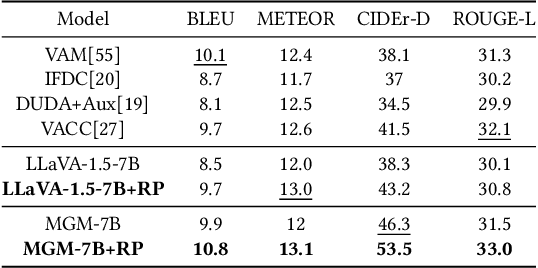
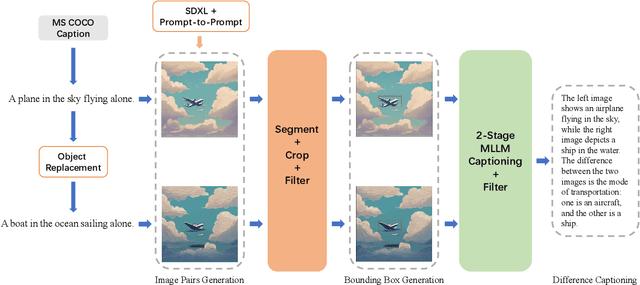
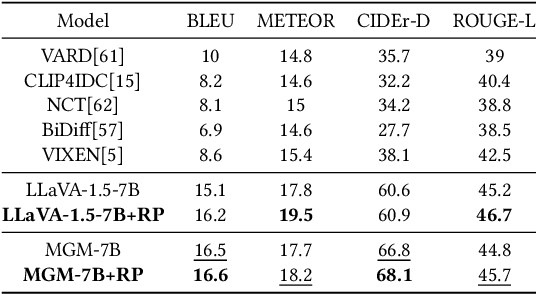
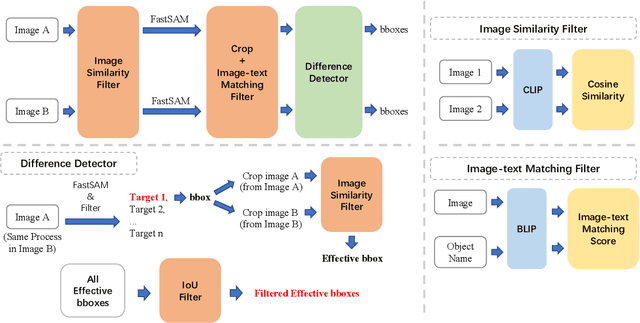
Abstract:High-performance Multimodal Large Language Models (MLLMs) rely heavily on data quality. This study introduces a novel dataset named Img-Diff, designed to enhance fine-grained image recognition in MLLMs by leveraging insights from contrastive learning and image difference captioning. By analyzing object differences between similar images, we challenge models to identify both matching and distinct components. We utilize the Stable-Diffusion-XL model and advanced image editing techniques to create pairs of similar images that highlight object replacements. Our methodology includes a Difference Area Generator for object differences identifying, followed by a Difference Captions Generator for detailed difference descriptions. The result is a relatively small but high-quality dataset of "object replacement" samples. We use the the proposed dataset to finetune state-of-the-art (SOTA) MLLMs such as MGM-7B, yielding comprehensive improvements of performance scores over SOTA models that trained with larger-scale datasets, in numerous image difference and Visual Question Answering tasks. For instance, our trained models notably surpass the SOTA models GPT-4V and Gemini on the MMVP benchmark. Besides, we investigate alternative methods for generating image difference data through "object removal" and conduct a thorough evaluation to confirm the dataset's diversity, quality, and robustness, presenting several insights on the synthesis of such a contrastive dataset. To encourage further research and advance the field of multimodal data synthesis and enhancement of MLLMs' fundamental capabilities for image understanding, we release our codes and dataset at https://github.com/modelscope/data-juicer/tree/ImgDiff.
Data-Juicer Sandbox: A Comprehensive Suite for Multimodal Data-Model Co-development
Jul 16, 2024



Abstract:The emergence of large-scale multi-modal generative models has drastically advanced artificial intelligence, introducing unprecedented levels of performance and functionality. However, optimizing these models remains challenging due to historically isolated paths of model-centric and data-centric developments, leading to suboptimal outcomes and inefficient resource utilization. In response, we present a novel sandbox suite tailored for integrated data-model co-development. This sandbox provides a comprehensive experimental platform, enabling rapid iteration and insight-driven refinement of both data and models. Our proposed "Probe-Analyze-Refine" workflow, validated through applications on state-of-the-art LLaVA-like and DiT based models, yields significant performance boosts, such as topping the VBench leaderboard. We also uncover fruitful insights gleaned from exhaustive benchmarks, shedding light on the critical interplay between data quality, diversity, and model behavior. With the hope of fostering deeper understanding and future progress in multi-modal data and generative modeling, our codes, datasets, and models are maintained and accessible at https://github.com/modelscope/data-juicer/blob/main/docs/Sandbox.md.
The Synergy between Data and Multi-Modal Large Language Models: A Survey from Co-Development Perspective
Jul 11, 2024Abstract:The rapid development of large language models (LLMs) has been witnessed in recent years. Based on the powerful LLMs, multi-modal LLMs (MLLMs) extend the modality from text to a broader spectrum of domains, attracting widespread attention due to the broader range of application scenarios. As LLMs and MLLMs rely on vast amounts of model parameters and data to achieve emergent capabilities, the importance of data is receiving increasingly widespread attention and recognition. Tracing and analyzing recent data-oriented works for MLLMs, we find that the development of models and data is not two separate paths but rather interconnected. On the one hand, vaster and higher-quality data contribute to better performance of MLLMs, on the other hand, MLLMs can facilitate the development of data. The co-development of multi-modal data and MLLMs requires a clear view of 1) at which development stage of MLLMs can specific data-centric approaches be employed to enhance which capabilities, and 2) by utilizing which capabilities and acting as which roles can models contribute to multi-modal data. To promote the data-model co-development for MLLM community, we systematically review existing works related to MLLMs from the data-model co-development perspective. A regularly maintained project associated with this survey is accessible at https://github.com/modelscope/data-juicer/blob/main/docs/awesome_llm_data.md.
Enhancing Multimodal Large Language Models with Vision Detection Models: An Empirical Study
Jan 31, 2024Abstract:Despite the impressive capabilities of Multimodal Large Language Models (MLLMs) in integrating text and image modalities, challenges remain in accurately interpreting detailed visual elements. This paper presents an empirical study on enhancing MLLMs with state-of-the-art (SOTA) object detection and Optical Character Recognition models to improve fine-grained image understanding and reduce hallucination in responses. Our research investigates the embedding-based infusion of detection information, the impact of such infusion on the MLLMs' original abilities, and the interchangeability of detection models. We conduct systematic experiments with models such as LLaVA-1.5, DINO, and PaddleOCRv2, revealing that our approach not only refines MLLMs' performance in specific visual tasks but also maintains their original strengths. The resulting enhanced MLLMs outperform SOTA models on 9 out of 10 benchmarks, achieving an improvement of up to 12.99% on the normalized average score, marking a notable advancement in multimodal understanding. We release our codes to facilitate further exploration into the fine-grained multimodal dialogue capabilities of MLLMs.
Data-Juicer: A One-Stop Data Processing System for Large Language Models
Sep 05, 2023Abstract:The immense evolution in Large Language Models (LLMs) has underscored the importance of massive, diverse, and high-quality data. Despite this, existing open-source tools for LLM data processing remain limited and mostly tailored to specific datasets, with an emphasis on the reproducibility of released data over adaptability and usability, inhibiting potential applications. In response, we propose a one-stop, powerful yet flexible and user-friendly LLM data processing system named Data-Juicer. Our system offers over 50 built-in versatile operators and pluggable tools, which synergize modularity, composability, and extensibility dedicated to diverse LLM data processing needs. By incorporating visualized and automatic evaluation capabilities, Data-Juicer enables a timely feedback loop to accelerate data processing and gain data insights. To enhance usability, Data-Juicer provides out-of-the-box components for users with various backgrounds, and fruitful data recipes for LLM pre-training and post-tuning usages. Further, we employ multi-facet system optimization and seamlessly integrate Data-Juicer with both LLM and distributed computing ecosystems, to enable efficient and scalable data processing. Empirical validation of the generated data recipes reveals considerable improvements in LLaMA performance for various pre-training and post-tuning cases, demonstrating up to 7.45% relative improvement of averaged score across 16 LLM benchmarks and 16.25% higher win rate using pair-wise GPT-4 evaluation. The system's efficiency and scalability are also validated, supported by up to 88.7% reduction in single-machine processing time, 77.1% and 73.1% less memory and CPU usage respectively, and 7.91x processing acceleration when utilizing distributed computing ecosystems. Our system, data recipes, and multiple tutorial demos are released, calling for broader research centered on LLM data.
DeepMAD: Mathematical Architecture Design for Deep Convolutional Neural Network
Mar 05, 2023



Abstract:The rapid advances in Vision Transformer (ViT) refresh the state-of-the-art performances in various vision tasks, overshadowing the conventional CNN-based models. This ignites a few recent striking-back research in the CNN world showing that pure CNN models can achieve as good performance as ViT models when carefully tuned. While encouraging, designing such high-performance CNN models is challenging, requiring non-trivial prior knowledge of network design. To this end, a novel framework termed Mathematical Architecture Design for Deep CNN (DeepMAD) is proposed to design high-performance CNN models in a principled way. In DeepMAD, a CNN network is modeled as an information processing system whose expressiveness and effectiveness can be analytically formulated by their structural parameters. Then a constrained mathematical programming (MP) problem is proposed to optimize these structural parameters. The MP problem can be easily solved by off-the-shelf MP solvers on CPUs with a small memory footprint. In addition, DeepMAD is a pure mathematical framework: no GPU or training data is required during network design. The superiority of DeepMAD is validated on multiple large-scale computer vision benchmark datasets. Notably on ImageNet-1k, only using conventional convolutional layers, DeepMAD achieves 0.7% and 1.5% higher top-1 accuracy than ConvNeXt and Swin on Tiny level, and 0.8% and 0.9% higher on Small level.
Enhancing Model Performance in Multilingual Information Retrieval with Comprehensive Data Engineering Techniques
Feb 14, 2023Abstract:In this paper, we present our solution to the Multilingual Information Retrieval Across a Continuum of Languages (MIRACL) challenge of WSDM CUP 2023\footnote{https://project-miracl.github.io/}. Our solution focuses on enhancing the ranking stage, where we fine-tune pre-trained multilingual transformer-based models with MIRACL dataset. Our model improvement is mainly achieved through diverse data engineering techniques, including the collection of additional relevant training data, data augmentation, and negative sampling. Our fine-tuned model effectively determines the semantic relevance between queries and documents, resulting in a significant improvement in the efficiency of the multilingual information retrieval process. Finally, Our team is pleased to achieve remarkable results in this challenging competition, securing 2nd place in the Surprise-Languages track with a score of 0.835 and 3rd place in the Known-Languages track with an average nDCG@10 score of 0.716 across the 16 known languages on the final leaderboard.
DAMO-YOLO : A Report on Real-Time Object Detection Design
Dec 15, 2022



Abstract:In this report, we present a fast and accurate object detection method dubbed DAMO-YOLO, which achieves higher performance than the state-of-the-art YOLO series. DAMO-YOLO is extended from YOLO with some new technologies, including Neural Architecture Search (NAS), efficient Reparameterized Generalized-FPN (RepGFPN), a lightweight head with AlignedOTA label assignment, and distillation enhancement. In particular, we use MAE-NAS, a method guided by the principle of maximum entropy, to search our detection backbone under the constraints of low latency and high performance, producing ResNet-like / CSP-like structures with spatial pyramid pooling and focus modules. In the design of necks and heads, we follow the rule of "large neck, small head". We import Generalized-FPN with accelerated queen-fusion to build the detector neck and upgrade its CSPNet with efficient layer aggregation networks (ELAN) and reparameterization. Then we investigate how detector head size affects detection performance and find that a heavy neck with only one task projection layer would yield better results. In addition, AlignedOTA is proposed to solve the misalignment problem in label assignment. And a distillation schema is introduced to improve performance to a higher level. Based on these new techs, we build a suite of models at various scales to meet the needs of different scenarios, i.e., DAMO-YOLO-Tiny/Small/Medium. They can achieve 43.0/46.8/50.0 mAPs on COCO with the latency of 2.78/3.83/5.62 ms on T4 GPUs respectively. The code is available at https://github.com/tinyvision/damo-yolo.
A Semantic Alignment System for Multilingual Query-Product Retrieval
Aug 05, 2022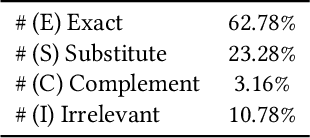
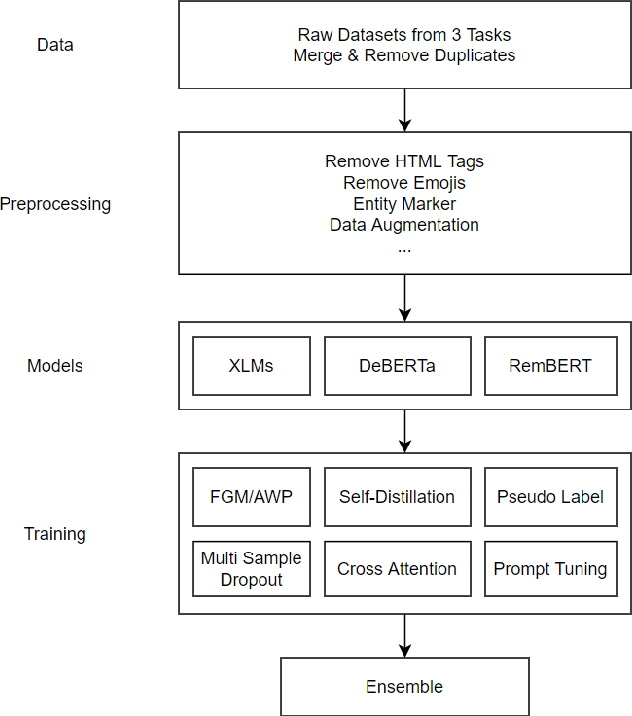
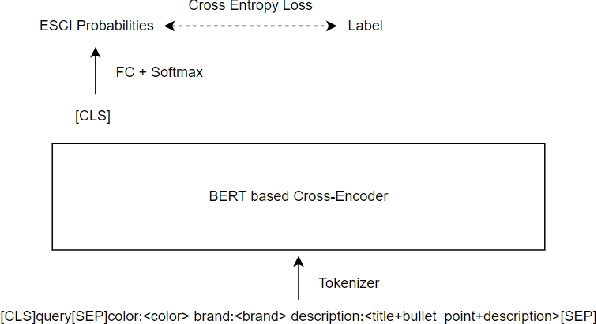
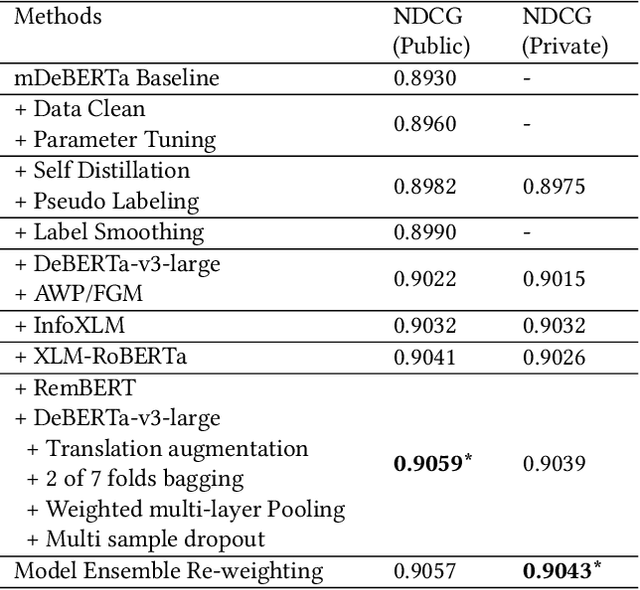
Abstract:This paper mainly describes our winning solution (team name: www) to Amazon ESCI Challenge of KDD CUP 2022, which achieves a NDCG score of 0.9043 and wins the first place on task 1: the query-product ranking track. In this competition, participants are provided with a real-world large-scale multilingual shopping queries data set and it contains query-product pairs in English, Japanese and Spanish. Three different tasks are proposed in this competition, including ranking the results list as task 1, classifying the query/product pairs into Exact, Substitute, Complement, or Irrelevant (ESCI) categories as task 2 and identifying substitute products for a given query as task 3. We mainly focus on task 1 and propose a semantic alignment system for multilingual query-product retrieval. Pre-trained multilingual language models (LM) are adopted to get the semantic representation of queries and products. Our models are all trained with cross-entropy loss to classify the query-product pairs into ESCI 4 categories at first, and then we use weighted sum with the 4-class probabilities to get the score for ranking. To further boost the model, we also do elaborative data preprocessing, data augmentation by translation, specially handling English texts with English LMs, adversarial training with AWP and FGM, self distillation, pseudo labeling, label smoothing and ensemble. Finally, Our solution outperforms others both on public and private leaderboard.
An Effective Way for Cross-Market Recommendation with Hybrid Pre-Ranking and Ranking Models
Mar 02, 2022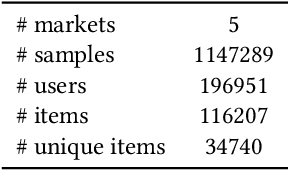

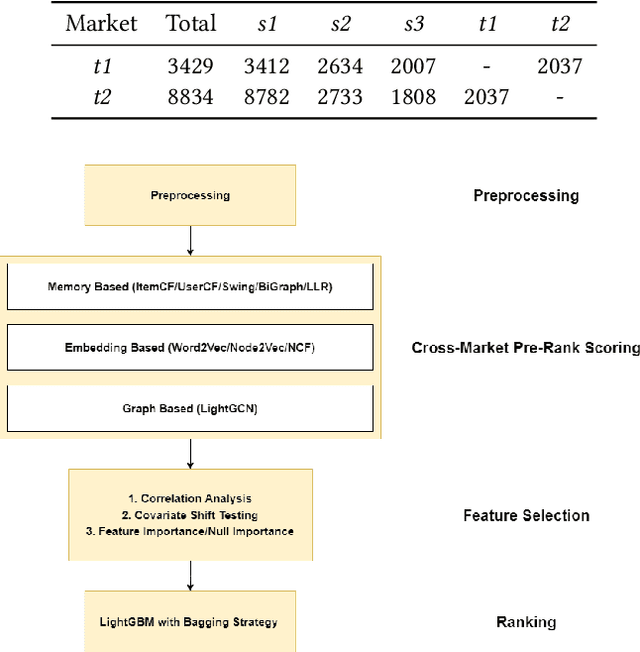

Abstract:The Cross-Market Recommendation task of WSDM CUP 2022 is about finding solutions to improve individual recommendation systems in resource-scarce target markets by leveraging data from similar high-resource source markets. Finally, our team OPDAI won the first place with NDCG@10 score of 0.6773 on the leaderboard. Our solution to this task will be detailed in this paper. To better transform information from source markets to target markets, we adopt two stages of ranking. In pre-ranking stage, we adopt diverse pre-ranking methods or models to do feature generation. After elaborate feature analysis and feature selection, we train LightGBM with 10-fold bagging to do the final ranking.
 Add to Chrome
Add to Chrome Add to Firefox
Add to Firefox Add to Edge
Add to Edge